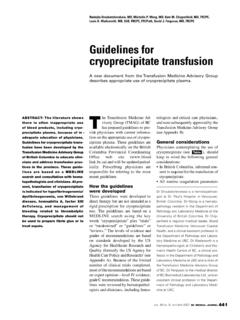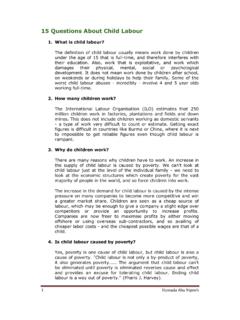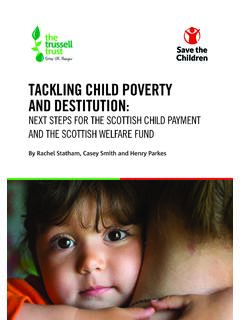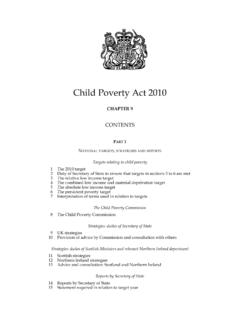Transcription of Children’s mental health: Is poverty the diagnosis?
1 Ivana Jakovljevic, MD, Ashley P. Miller, MDCM, FRCPC, Barbara Fitzgerald, MD, FRCPC. Children's mental health: Is poverty the diagnosis? Some of the concerns seen by childhood health professionals may not be diagnosable psychiatric conditions, but emotional and behavioral responses to family financial insecurity. ABSTRACT: The case of a 6-year-old status. poverty is a risk factor for Case data boy who was referred to a physician mental health conditions in child - A 6-year-old boy was referred for by his school counselor for inves- hood and is associated with lower assessment and treatment recom- tigation of anxiety and possible at- academic achievement and impaired mendations by his school counselor tention deficit hyperactivity disor- cognitive development secondary because of anxiety, school difficul- der illustrates the need to consider to direct effects on the developing ties, and possible attention deficit the role of poverty when addressing hypothalamic-pituitary-adrenal axis hyperactivity disorder (ADHD).
2 The mental health concerns. After deter- and indirect effects on a child 's en- boy was from a two-parent family mining that income insecurity could vironment. British Columbia's child - and had a 14-year-old brother. Both be contributing to the boy's symp- hood poverty rate is well above the parents were employed, the father toms, the physician used a poverty national average and is compounded as a cargo delivery driver and the intervention tool to screen for the by significant unmet core housing mother in a hospital cafeteria. The effects of poverty and make rec- need and widening provincial income boy's mother had started shift work 6. ommendations to prevent adverse disparity. We recommend screening months previously and was working 6. health outcomes. mental health and for poverty with office-based inter- days a week so that the family could behavioral concerns are common ventions and accounting for income meet increasing rent costs.
3 They in children and youth presenting insecurity in all mental health diag- lived in a small two-bedroom apart- with undifferentiated complaints in noses and treatment plans. We also ment and the boy slept on the pull-out both pediatric and primary care set- strongly recommend implementing a couch in the living room because his tings. Psychiatric disorders are fre- national poverty reduction strategy 14-year-old brother demanded priva- quently multifactorial and require a to address social determinants of comprehensive assessment of the health in the early years and improve Dr Jakovljevic is a PGY-5 resident in the De- patient's environmental context, in- the health of future generations. partment of Psychiatry at the University of cluding the family's socioeconomic British Columbia. Dr Miller is an assistant professor in the Department of Psychiatry at UBC and a child and adolescent psychia- trist at BC Children's Hospital and Vancou- ver Community mental Health Services.
4 Dr Fitzgerald is a developmental pediatrician at Sunny Hill Health Centre for Children. She is also medical director of Alderwood Family Development Centre and a clinical associate professor in the Department of This article has been peer reviewed. Pediatrics at UBC. 454 bc medical journal vol. 58 no. 8, october 2016 Children's mental health: Is poverty the diagnosis? cy. The family could no longer afford below the diagnostic threshold for care had placed stress on the family after-school care for the boy as they ADHD. Written reports indicated the and affected the boy's sense of secu- had done the previous year, so he was boy was slightly behind in reading rity. The impact of sleep on the boy's picked up from school by the broth- skills for his age. The father stated ability to pay attention and manage er and watched TV and played video that the separation anxiety and prob- emotions was discussed and infor- games every day after school while lems at school had begun 6 months mation about sleep hygiene and good his parents were working.
5 Earlier, coinciding with his mother's asthma management was provided. First visit The boy attended the first visit to the physician with his mother, who reported that the child had no previ- ous history of anxiety or psychiatric concerns but did have a medical his- The World Health Organization tory of asthma. The mother described has declared poverty the single the boy's recent separation anxiety, difficulty concentrating, trouble fall- largest determinant of health ing asleep, and tantrums during tran- for both adults and children. sitions at school. Teachers reported the boy was frequently anxious and inattentive in class. In the past the father had been diagnosed with a mild learning disability and the mother described herself as frequently anx- ious, although she had never been increased work hours, and that he had The parents were advised to file tax diagnosed with a psychiatric condi- started sleeping with his son on the returns so the family would be eligi- tion.
6 During the visit the boy was shy, pull-out couch because of the boy's ble for income supplements and sub- clung to his mother, and looked at her anxiety. sidized housing. Psychoeducational for answers. He occasionally gave Given the family's economic sit- testing was recommended to rule one-word answers to questions. There uation, the physician chose to use a out a learning disability, even though were no other significant findings on screening and intervention tool for there was likely to be a long wait for the mental status exam. Teacher and poverty . The father disclosed that the testing in the public system, the only parent checklists were provided to family had not had enough money for option for the family. The parents collect further details and a second necessities for the previous 9 months were advised to enquire about getting visit was scheduled to complete the and had recently started going to the their son extra help with homework assessment.
7 Food bank. The father also said he was through the school and were referred too ashamed to talk to his son's school to a parenting group for parents of Second visit about their circumstances and asked children with anxious temperaments. At the second visit with the physi- the physician about resources for sub- The physician emphasized the parents cian, the boy was accompanied by his sidized housing. The family had not were doing their best to care for their father. The boy's growth charts and filed a tax return for the previous year son and had given him a good founda- hearing and vision test results were because of the mother's transitional tion. A follow-up visit was scheduled. reviewed. No deficits were identi- employment. fied and he was found to be on track Information gathered at the sec- Third visit developmentally. His asthma, while ond visit led to a number of recom- At the third visit the parents reported relatively mild, was found to be con- mendations for the family.
8 The par- that their son was attending a subsid- tributing to sleep disturbances. Occa- ents were told that although their ized summer camp through his school. sional inattention and concentration child did not have a clinical anxiety The family had filed tax returns, ob- difficulties were noted on the teach- disorder or ADHD, their recent finan- tained low-cost transportation passes, er checklists, but the symptoms fell cial struggles and changes in child and been waitlisted for subsidized bc medical journal vol. 58 no. 8, october 2016 455. Children's mental health: Is poverty the diagnosis? housing. The boy was receiving a or ensured the boy received learning undifferentiated complaints. These free breakfast and lunch at school and assistance for reading and tutoring conditions can include anxiety disor- seeing the school counselor regular- from a local high school student. With ders, ADHD, and other neurodevel- ly. The parents, however, were still the physician's help, the parents even- opmental disorders.
9 In addition, child struggling financially and reported tually obtained a subsidy for quality abuse, trauma, and early adversity that their experiences had affected after-school care and established a can have a significant impact on all their relationship. Although they were clear routine for their son, including aspects of child development and be- very eager to join the parenting group, two 30-minute sessions a week when havior. As children are embedded in they were unable to attend because of he would go to the park or have spe- their environments, a comprehensive their work schedules and lack of child cial play time with his mother. Within assessment and consideration of their care options. 3 months, the boy's separation anxi- psychosocial circumstances is crucial for accurate diagnosis and treatment recommendations. Childhood poverty in BC. According to most recent estimates, approximately one in five BC children age 0 to 17 ( ) are living in pov- poverty becomes biologically embedded, erty,3 and the numbers are significant- ly higher for children of immigrants, leading to both functional and structural visible minorities, and Aboriginal cit- changes of the developing brain.
10 Izens. British Columbia's child pov- erty rate has remained consistently higher than the national average since 2000, and has increased significantly since the 1989 House of Commons all-party resolution to eliminate child Children of various fam- ily types live in poverty , but there is The mother was tearful during ety had improved significantly and an increase in working poor families the appointment, and said she would his teacher noted better focus in class living in British Columbia, with one love to be able to spend quality time despite the family's continued high in three poor children having at least with her son at home, like her own stress level and hectic work schedule one parent who works full time. As mother had with her, but was unable in attempts to make ends meet. of 2013, one-half of children in lone to leave her job. The mother was told parent families were living in poverty . that staying at home with children is Discussion Food bank use has increased by 25%.









